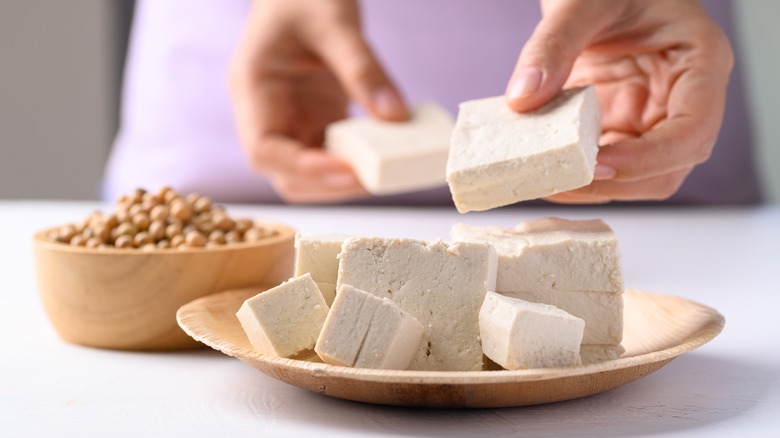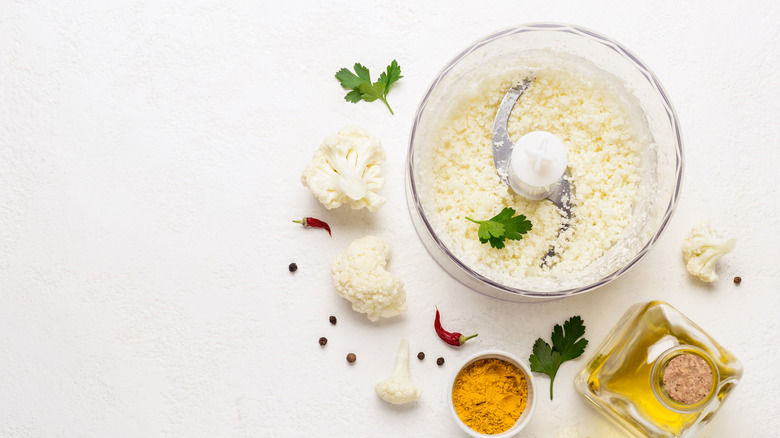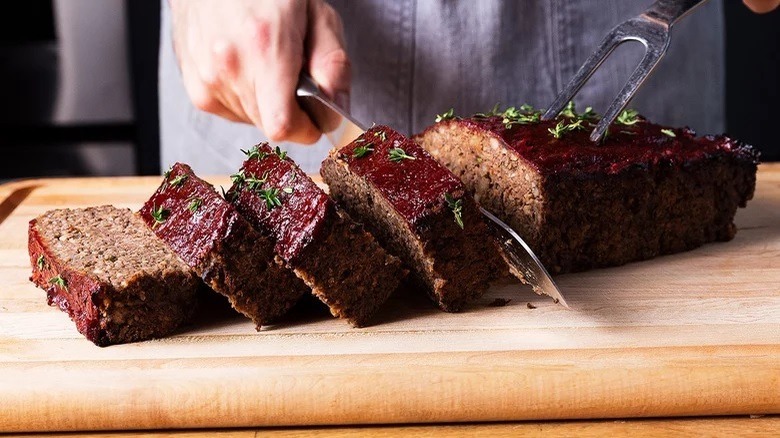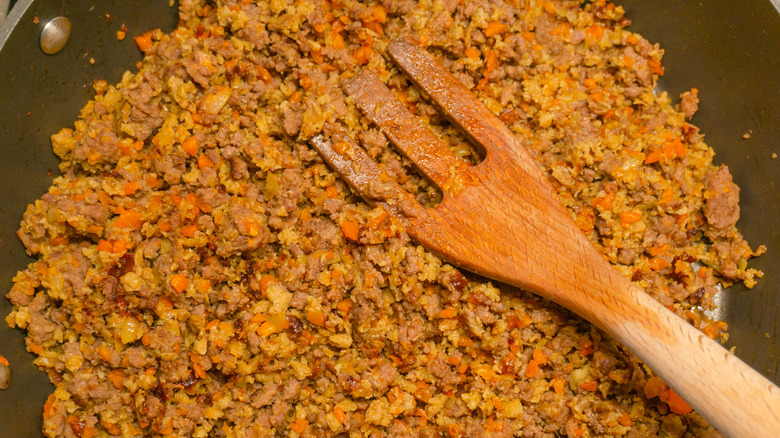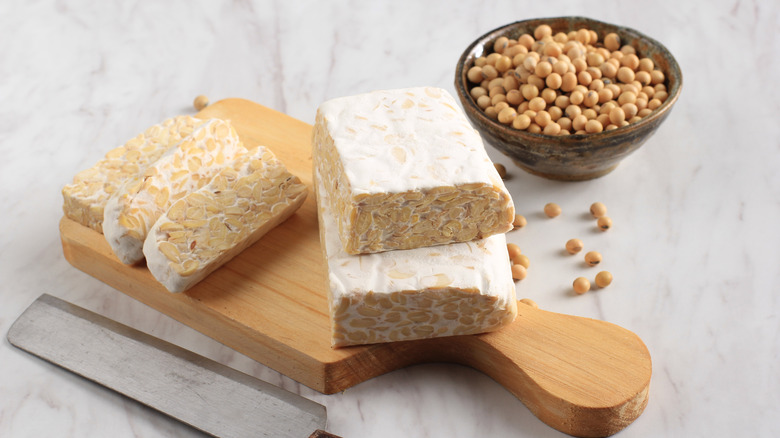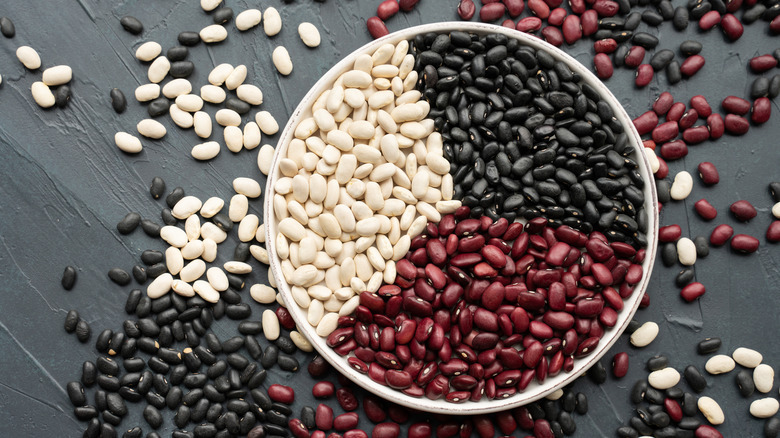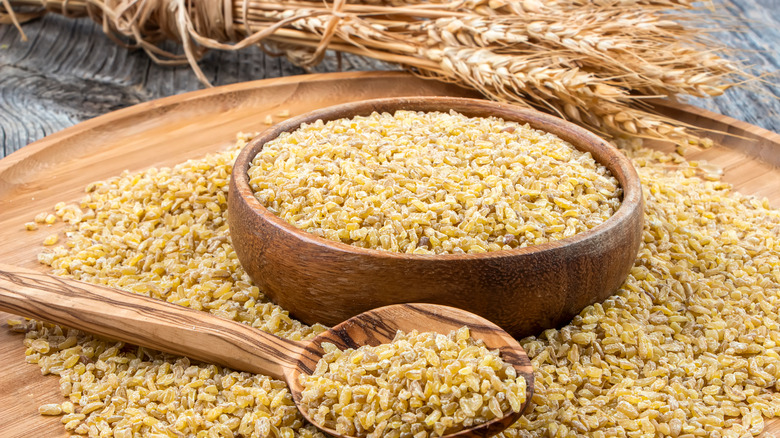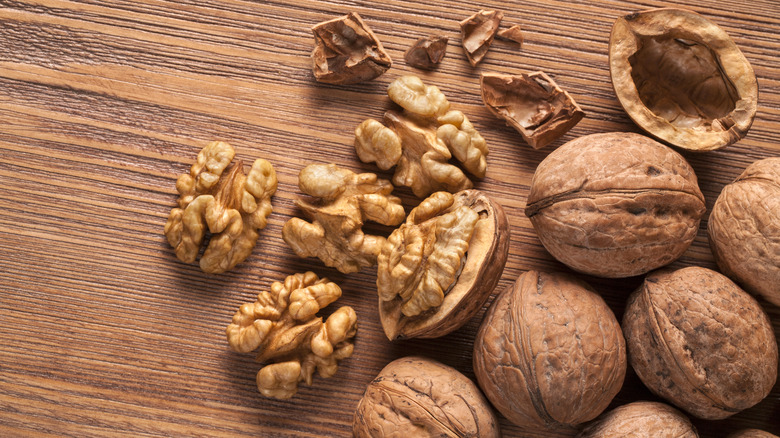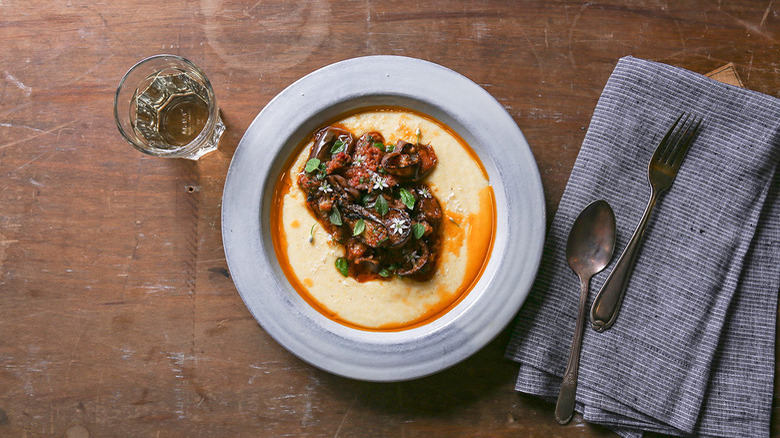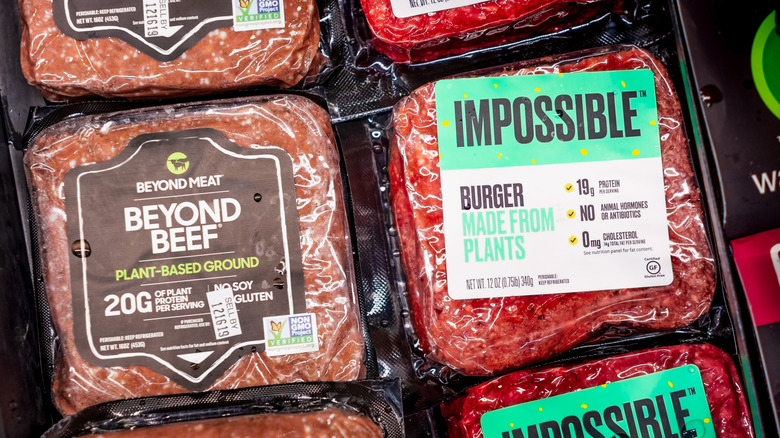10 Best Vegetarian Substitutes For Ground Beef
We may receive a commission on purchases made from links.
It's no secret that Americans love beef. According to a report by the United States Department of Agriculture, domestic beef disappearance (a measure similar to consumption) is expected to be around 59 pounds per capita in 2022. As data from 2020 has shown, even amid a pandemic, this relationship Americans have with beef is hard to sever. Even when the food supply systems were challenged from every angle, beef sales actually increased by 23.7% that year (via Insider), suggesting the great lengths we'll go to get our bovine fix.
Ground beef, a blend of trimmings from various cuts such as sirloin and chuck, is the most popular beef product sold in the U.S., accounting for nearly 40% of beef sales in 2021 (via Statista). Used in burgers, tacos, casseroles, pasta sauces, and more, it's rich in protein, iron, B12, zinc and other essential vitamins and minerals (Healthline).
There is, however, a well acknowledged need for more sustainable protein sources to help combat climate change and account for changing awareness and attitudes about animal consumption. According to Suzy Amis Cameron, founder of the MUSE School and author of "The OMD Plan," swapping just one meal a day to a vegetarian or vegan alternative, can make a huge difference from an environmental perspective. Next time you're preparing burgers or bolognese, consider these delicious meatless swaps for ground beef to help incorporate more plants into your diet.
Lentils
Used throughout a variety of cuisines across India, Asia, North Africa, Europe and the Middle East, lentils are as versatile as they are nutritious, providing a great source of protein, iron, fiber and folate (via Healthline). Though lentils are a longstanding and well-loved part of many cuisines worldwide, they're not as embraced by the U.S. as they could be. According to USA Pulses, the vast majority of the U.S. grown lentil crop is exported to other lentil-loving areas of the world where they're cooked down into dals, soaked for bread doughs, or sprinkled over salads. They're also a tasty vegetarian alternative to ground beef.
An easy ratio to remember when swapping in lentils for ground beef is 1 cup of dried, uncooked lentils is equivalent to 1 pound of ground beef. Once cooked, 1 cup of lentils will swell to around 2½ cups, which also works well on wallets by bulking out recipes, allowing a pot of chili to feed a few more guests at no extra cost. For best results, use some of the milder types of lentils like green and brown as a ground beef substitute. Red lentils, though beautiful in color, don't tend to hold their shape so they are best used when making creamy soups or smooth dals to account for them falling apart.
Firm tofu
Made from soy milk, tofu (also known as bean curd) has been eaten with gusto since the Han Dynasty in China (via SoyInfo Center). When an ingredient has been around as long as tofu, you can guarantee there will be hundreds of ways to use it to add texture and flavor alongside plant-based protein to a dish.
When substituting ground beef for firm tofu (ideal for its texture and ability to soak up flavor), Livestrong suggests a three-step process to successfully achieve a similar "beefy" texture. First, freeze your unopened block of tofu to help change the texture of the bean curd. Next, defrost the tofu, then crumble or shred the block, using your hands or a fork, to mimic the texture of ground beef. Incorporate plenty of herbs and spices when cooking to develop depth of flavor. Blogger and nutritionist Lyn of Cook Eat Live Love recommends adding umami-rich ingredients like soy sauce and nutritional yeast to a tofu crumble, before seasoning and baking for 30 minutes, in order to achieve a drier meat-like texture, ready to be turned into a taco filling or bolognese sauce.
Cauliflower
Cauliflower is a unique shape shifter of a vegetable. It's now used more widely perhaps than ever before as a vegetarian substitute for meat as more people have become familiar with its ability to easily soak up the flavors of sauces and spices. Packed with fiber, Vitamin C, antioxidants, and other necessary vitamins while remaining low in calories and carbohydrates, it makes for a nutritious addition to any dish (via Healthline). Prevalent meat-mimicking cooking techniques within the U.S. include slicing and grilling cauliflower like a juicy steak, roasting or braising it whole like brisket, and crumbling or ricing its florets into grain-sized pieces. Not only is it a popular low-carb substitution for rice itself when broken down into crumbles, but it's also a brilliant alternative for ground beef in dishes like tacos.
For a taco meat substitute, More Momma suggests ricing the cauliflower from the whole plant itself, rather than purchasing the pre-cut kind, to reduce any excess water for easier browning and a more meat-like texture. Then season as you would ground beef to make a delicious vegetarian taco filling, complete with all the toppings and condiments your heart desires.
Mushrooms
Though lower in protein than ground beef, according to BBC Good Food, mushrooms are vitamin and mineral powerhouses, bursting with selenium, zinc, vitamin B1, B2, B5, B6 and B12. Another bonus: Swapping fungus for meat is environmentally friendly. Given the numerous types of mushrooms that grow easily all over the world, cooks are spoilt for choice when it comes to using these umami-rich fungi to replace meats like ground beef. When choosing more sun-exposed varieties like morels and chanterelles, they can also be used as a vegan source for vitamin D. Opt for juicy portobello in place of a beef burger (anyone who lived through the '90s restaurant scene should be familiar with that swap). Consider a milder mushroom like crimini in place of beef in a stroganoff or cream sauce.
Try stronger, shiitake mushrooms as a meaty substitute, especially as a complement to Asian ingredients like soy, miso, and tamari. For a vegetarian version of an old-school American favorite, try our comforting vegan mushroom meatloaf recipe. Finely chop your mushrooms then combine them with coarsely ground walnuts before adding a ketchup glaze — undoubtedly the best part of any meatloaf, vegan or otherwise.
Seitan
Used widely throughout China and Japan for centuries, seitan, aka "wheat meat," was introduced into the U.S. culinary scene in the 1960s as part of the macrobiotic diet (via Love Seitan). Due to its firm, easy-to-use texture and high protein make-up, it has become increasingly popular as a delicious vegetarian substitute, not just at home but increasingly on restaurant menus as vegan and vegetarian dining options continue to expand (via Technavio). However, it does contain gluten so isn't safe for those with gluten allergies such as Celiac disease.
You can buy seitan ready-made in grocery stores and health food stores, often found near the tofu. When storing, i am a food blog suggests refrigerating it either wrapped or sealed for no longer than one week before using.
Seitan can be prepared in a variety of ways to replace meat in a dish. In order to mimic ground beef, first ground it in a food processor to achieve a crumbled texture. Then, according to One Green Planet, the trick is to season it well before cooking with ingredients like nutritional yeast, herbs, vegetable broth, tamari, tomato paste, or soy sauce. Because seitan is naturally quite dry, it readily absorbs the flavors of sauces and broths, making it an easy and flavorful replacement for ground beef in tacos, chili, sloppy joes, and more.
Tempeh
This Indonesian staple is made from whole fermented soybeans and delivers a rich nutty taste and a wonderful meat-like texture. Used widely throughout Indonesia and now globally, tempeh is an incredible vegan substitute for meat from burgers to bacon to Buddha bowls, as detailed by Chinese-Indonesian Australian chef Lara Lee in her cookbook "Coconut & Sambal." Tempeh's natural depth of flavor pairs perfectly with a wide variety of sauces and cuisines, which means you can simply pick some up at the grocery store or Asian supermarket without having a specific plan for how you'll use it.
Jaime Bachtell-Shelbert includes crumbled tempeh in place of ground beef for her satisfying and nourishing vegetarian goulash recipe. Bachtell-Shelbert recommends cooking the tempeh much like you would ground beef by browning and sautéing it along with onions and peppers at the beginning of the dish. You can also use it crumbled and sautéed with olive oil and your favorite Mexican spices for an easy vegan taco filling, per Happy Kitchen Rocks.
Beans
That old terrible nursery rhyme "Beans, beans good for your heart ... " has some truth to it. Studies show that the risk of heart disease may be lower for those who regularly consume these environmentally sustainable, high-fiber ingredients (via The Washington Post). Beans are used in a wide variety of ways around the world. According to Whetstone Magazine, they have been used to fuel humankind for over 5000 years, originating with Indigenous peoples of the Americas who grew them in harmony with corn and squash. They are incredibly economical to buy, whether canned or dried, and there are several types of beans to choose from; black, pinto, navy, kidney, cannellini ... the list goes on.
If you're a newly minted bean eater, The Washington Post suggests increasing consumption gradually by replacing one-third to half of the ground beef in a recipe, to help ease digestion while your body adjusts. For creamier recipes, Connoisseurus Veg recommends using a milder bean like cannellini. When using stronger flavored varieties like red kidney beans in our three-bean chili recipe, amp up the acidity with a squeeze of lime juice for brightness.
There's a hot debate as to whether or not you need to soak dried beans before cooking, but the overarching opinion seems to be that soaking increases digestibility, especially if the beans are old — but it's not 100% necessary.
Bulgur wheat
This hearty, toothsome, ancient grain made from wheat berries is used throughout the Middle East and Mediterranean regions. Bulgar makes a terrific substitute for ground beef and may, in fact, be more filling and satisfying, due to its fiber-rich make up. High in iron, folate, and Vitamin B6, it has been keeping people going since its mention in The Old Testament (via Sunnyland Mills).
When making bulgur wheat, The Mom 100 suggests a total cooking time of around 20 minutes (10 spent simmering and the remaining half spent soaking while covered, after the pot is removed from heat). Use a ratio of 1 ¾ cups water to 1 cup dried bulgur. When substituting bulgur in for meat, Thrifty Jinxy recommends substituting one cup of uncooked bulgur wheat for every pound of ground beef, an easy conversion applicable to most recipes. Those who are new to this ancient and hearty ingredient should consider replacing half of the ground beef with bulgur wheat first before going the whole hog, or, in this case, harvest.
Walnuts
Often used in conjunction with another ingredient such as cauliflower, beans, mushrooms, or bulgur wheat, walnuts are a perfect vegetarian substitution for ground beef. They are not only rich in protein, but also phosphorus, vitamin B6, and folic acid (via BBC Good Food).
There are many ways to use walnuts as a ground beef substitute. California Walnuts suggests using them instead of ground beef for everything from burgers to meatballs. Brittany and Terrence of The Plant Power Couple blog recommend soaking walnuts for a minimum of 20 minutes for optimum texture. They can then be kept in the fridge for up to a week or frozen for longer. While soaking is preferred by some, it isn't always a requirement. (When it comes to pre-soaking, it all seems to depend on personal preference of texture.) Regardless of what you decide to make with walnuts, keep in mind that they spoil quickly, so be sure to store them somewhere cool or dry.
Eggplant
Not just for parm, eggplant, with its meaty texture and earthy taste, is a perfect vegetable substitute for ground beef. Originally from China and India, these members of the Nightshade family have made their way around the world, thanks to many diaspora communities (via Harvesting History). Eggplants are happiest when grown in warmer climates, which explains why they play such a prevalent role in many Mediterranean and Middle Eastern cuisines.
Bolognese fans are sure to appreciate our hearty eggplant ragout with creamy polenta recipe which is an ideal dish for the fall. The delicious mash of eggplant, garlic, and shallots (which is simmered in red wine) can also be served over the pasta of your choice. If you prefer meatballs, consider cookbook author Yotam Ottolenghi's eggplant dumplings. Roast the eggplants until tender before mashing, cooling, and then combining with ricotta and parmesan for a rich and satisfyingly savory result (via The Guardian).
Plant-based ground
No longer limited to stalwarts such as Morningstar Farms or Boca (though they're still great options), the plant-based meat alternative industry continues to grow. According to a 2020 report from the Good Food Institute, there are over 800 brands globally that focus largely on creating plant-based alternatives to meat, dairy, and eggs. Companies are working to match (and encourage) the increasing demand as, according to the same report, plant-based sales in the U.S. increased by 45% in 2020. No wonder the plant-based section of the grocery store seems to be getting bigger by the day!
Some of these brands, like Beyond Meat and Impossible Foods, offer plant-based versions of ground beef that are remarkably similar to the real thing. These can be substituted and cooked just as you would its cow-based counterpart. Companies are also working to make the swap as convenient as possible by offering a plethora of ready-made items like meatballs and burgers to further reduce prep time in the kitchen and encourage a seamless swap to more plant-based products.


